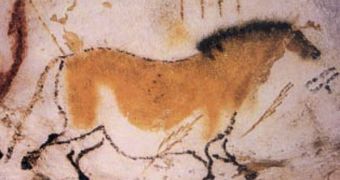More than 16,000 years ago, a group of humans took refuge in the Lascaux caves, in what is now southwestern France, probably living a nomadic existence and seeking refuge from predators. In the course of their stay, they inscribed the walls with primitive drawings of animals that they saw on their perilous journeys, pictures that were since forgotten and were only again discovered on September 12th, 1940. Since then, efforts of protecting the drawings from decay have been ongoing, and, four years ago, experts sprayed the walls against fungi, which threatened the murals. Now, because of that, new types of bacteria have begun devouring the priceless paintings.
Of the approximately 2,000 images that were found on the walls, about 900 are still well enough preserved to be made out. Horses, stags, felines, birds, bears, cattle, bison, a rhinoceros and a human make up the most massive collection of prehistoric cave art in the world today. They are all coming under threat from black mold, which experts are currently trying to keep away from the cultural artifacts. The Fusarium solani fungus, as well as other bacterial populations, which only appeared after the original spraying efforts, are however difficult to keep in check, and experts are currently looking for new ways of getting rid of them.
“The Lascaux cave is now a reservoir of potential pathogenic bacteria and protozoa similar to those found in disease outbreaks linked to contaminated air-conditioning systems and cooling towers in hospitals and public buildings,” explained Seville, Spain-based Spanish Institute of Natural and Agrobiological Research expert Cesareo Saiz-Jimenez. He is a member of the team involved with the conservation efforts. The benzalkonium chloride spray that is responsible for the current state of affairs was applied progressively, between 2001 and 2004.
Some say that it was the discovery of the cave that triggered the decay of the paintings. Since it was opened to the public, more than 1,800 people have visited it every day, until it was closed for viewing, in 1965. Their breath would have significantly altered the environment of the cave, as did the artificial light and the air conditioning systems that were installed at the location. Thus, murals that have endured for about 16,000 years started getting affected by the new atmosphere, which sported numerous types of bacteria that were new to the secluded environment.
At this point, the cave is off-limits to even conservationists and historians. Hermetically sealed. The entrance only opens once every week for a single individual, who monitors climate conditions. Occasionally, a larger science team is allowed in, to conduct maintenance work on the walls, and to assess the condition of the drawings, NewScientist reports.

 14 DAY TRIAL //
14 DAY TRIAL //